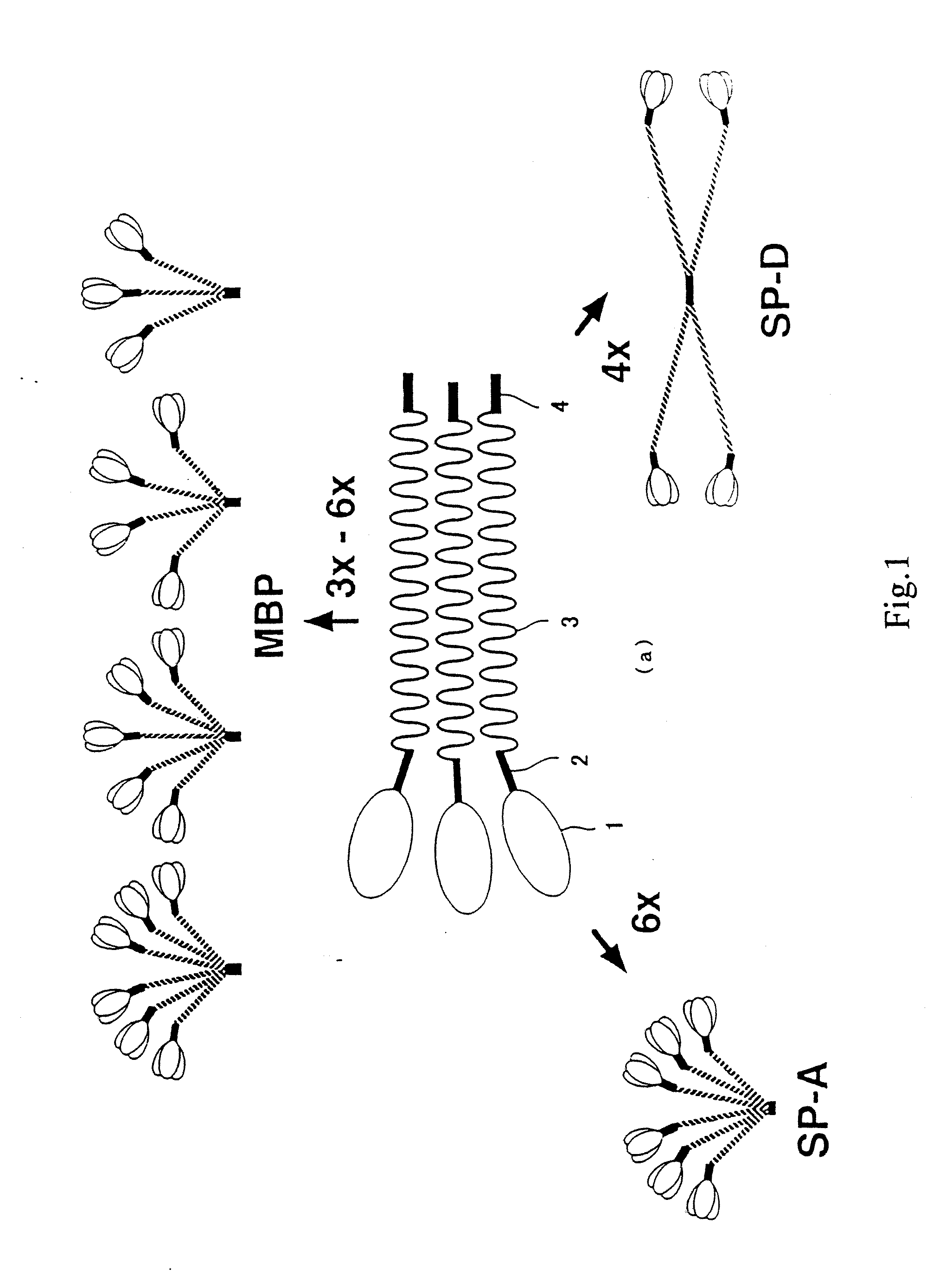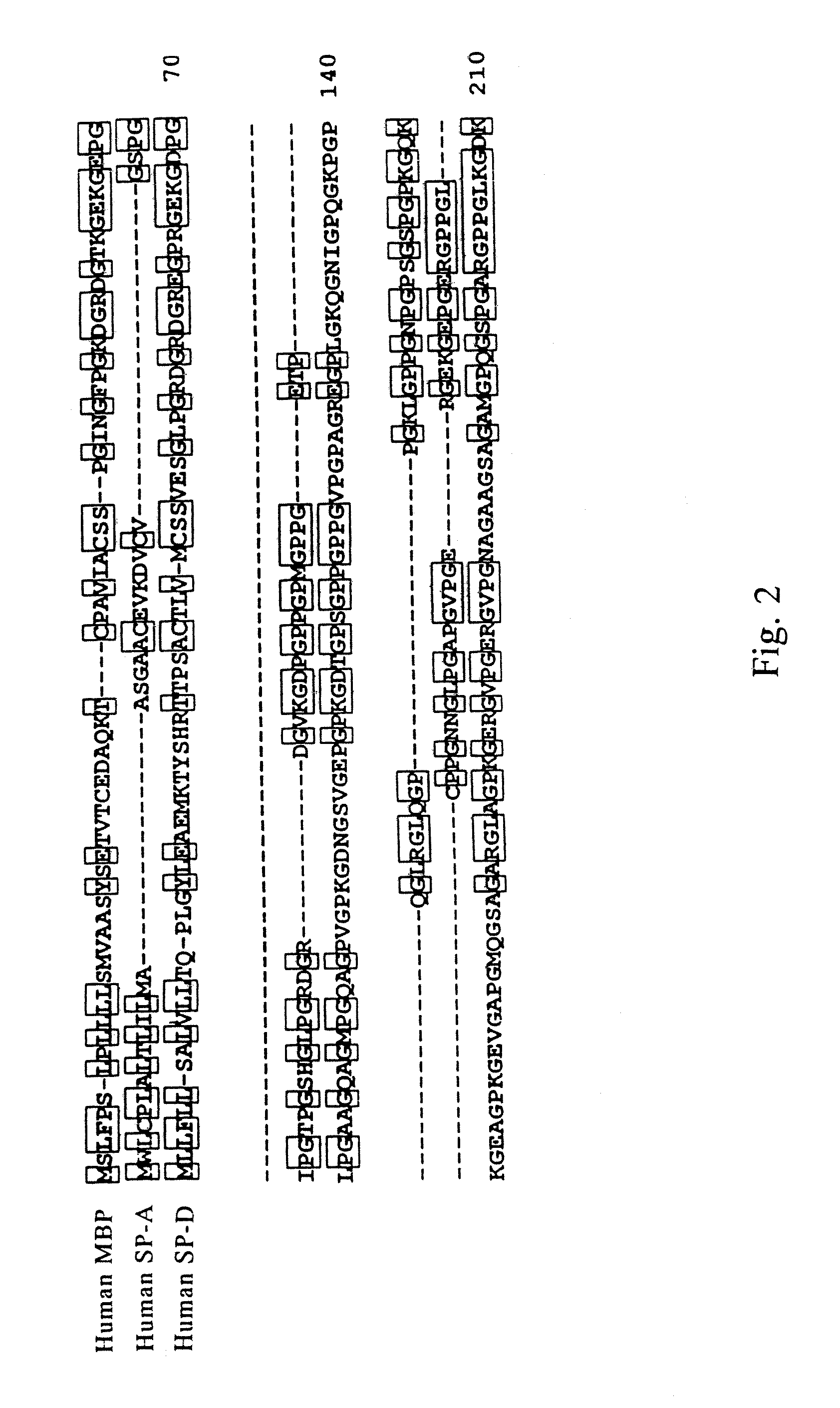Novel scavenger receptor
a scavenger receptor and novel technology, applied in the field of novel scavenger receptors of human and mouse, can solve the problems of cell injury characteristic of diabetic complications
- Summary
- Abstract
- Description
- Claims
- Application Information
AI Technical Summary
Benefits of technology
Problems solved by technology
Method used
Image
Examples
example 1
Search on EST Database
[0173] By comparing amino acid sequences of known collecting, i.e., human MBP, human SP-A and human SP-D (see, FIGS. 2 and 3, wherein, circumscribed amino acid residues denote the part that are recognized to be homologous), a region highly conserved between the molecules was searched. Consequently, it was revealed that 27 amino acids corresponding to from position 220 to position 246 of the human MBP amino acid sequence (FIG. 3, outlined characters, SEQ ID NO: 5) were highly conserved. Therefore, several consensus sequences in compliance with this region were produced, and search on EST (Expressed Sequence Tags) database was conducted. EST database that was employed contained 676750 sequences dated Oct. 11, 1996.
[0174] As a result, several data were obtained for highly homologous amino acid sequence to the 27 amino acids described above. The amino acid sequences of thus resultant data were searched on GenBank / EST database, and determined whether they were any...
example 2
Preparation of Probes for Screening
[0176] The nucleotide sequence of an insert DNA of the above-described clone was sequenced with a primer (Pharmacia Co., M13 Universal Primer (SEQ ID NO: 7,5′-fluorescein-cgacgttgtaaaacgacggccagt-3′) and M13 Reverse Primer (SEQ ID NO: 8, 5′-fluorescein-caggaaacagctatgac-3′)).
[0177] Thus resulting nucleotide sequences was aligned to the amino acid sequence of an open reading flame of a collectin, and then a nucleotide sequence corresponding to the amino acid sequence that can be read therefrom was extracted. Primers for digoxigenin (DIG) labeled cDNA probe that correspond to a part of the extracted sequence (Reverse primer: caatctgatgagaaggtgatg (SEQ ID NO: 9) and Forward primer: acgaggggctggatgggacat (SEQ ID NO: 10)) were produced using Applied Biosystems Inc., 392A DNA / RNA synthesizer. DIG labeling was conducted using a PCR DIG probe synthesis kit (Boeringer Mannheim Co., Ltd). The constitution of a reaction is as follows: 2 μl (100 ng) of plasm...
example 3
Screening of cDNA Library Derived from Human Placenta
[0178] A phage cDNA library derived from human placenta was first subjected to the titration as follows. A solution of 0.2 ml of Escherichia coli Y1090r, which had been cultured in mLB medium (LB medium (1g triptone, 0.5 g yeast extract, 0.5 g NaCl / 100 ml) containing 10 mM MgSO□ and 0.2% maltose) at 37° C. for 16 hours, and 0.1 ml of cDNA library serially diluted with SM buffer (5.8 g NaCl, 2g MgSO□.7H□O, 25 ml of 2 M Tris-HCl (pH 7.5), 5 ml of 2% gelatin / L) were incubated at 37° C. for 15 min. Thereafter, the mixture was added to 2.5 ml of LB-TOP agarose (0.75% agarose / LB medium) to give a homogenous mixture, and plated on 90 mmΦ LB medium plate (Iwaki glass Co., Ltd.) (1.5% agar / LB medium). The medium was hardened in 15 minutes at room temperature, followed by incubation at 42° C. for 5 hours. After counting the plaque number of each plate, the titer of phage of each plate was calculated. As a result, the titer was calculated t...
PUM
| Property | Measurement | Unit |
|---|---|---|
| temperature | aaaaa | aaaaa |
| pH | aaaaa | aaaaa |
| temperature | aaaaa | aaaaa |
Abstract
Description
Claims
Application Information
 Login to View More
Login to View More - R&D
- Intellectual Property
- Life Sciences
- Materials
- Tech Scout
- Unparalleled Data Quality
- Higher Quality Content
- 60% Fewer Hallucinations
Browse by: Latest US Patents, China's latest patents, Technical Efficacy Thesaurus, Application Domain, Technology Topic, Popular Technical Reports.
© 2025 PatSnap. All rights reserved.Legal|Privacy policy|Modern Slavery Act Transparency Statement|Sitemap|About US| Contact US: help@patsnap.com



